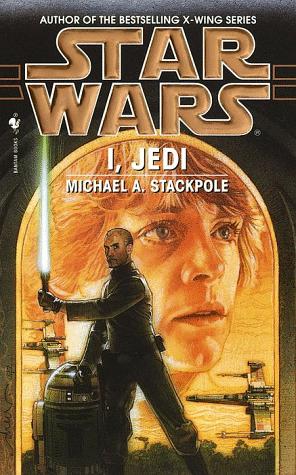Today, I doubt anybody would let Michael A. Stackpole get away with what he did in 1998. If you were to ask me, right now in 2014, what I thought of a Star Wars novel written in the first person featuring a character who never appears in any of the novels movies, running through a plot which retcons events of beloved novels from a few years before, I’d say there’s zero market for such a book.
I, Jedi is a niche inside of a niche inside of niche, which is actually why it’s wonderful. And though it might not be the best Star Wars book of them all, it is easily the best Star Wars novel.
With the first X-Wing book—Rogue Squadron—I mentioned the very reasonable concern someone might have that these books are nothing more than marketing tie-ins to create more interest in popular video games. And while the Star Wars expanded universe certainly is guilty of creating a few characters and storylines which seem designed only to get certain people to buy toys and trading cards (Dash Rendar?) I think I, Jedi firmly establishes Stackpole’s Corran Horn as his own kind of literary hero. Sure, Corran is derivative of some sort of ex-space cop character who blends both the jaded qualities of Han Solo with the good-heartedness of Luke Skywalker, but hey, you knew this was derivative because it’s a Star Wars novel.
What do these kinds of novels have going against them when placed under the tweedy microscope of “serious” literary criticism? Everything! Novels which take place in an established pop-media universe are occasionally seen as decent science fiction novels, but few literary critics would touch a Star Wars book—of any kind—with even a crappy toy lightsaber. But if a tie-in media book is a like a fighter pilot with one purpose, then a tie-in media novel that tries to be something more is like… an aspiring Jedi!
Michael A. Stackpole’s I, Jedi is the only (ONLY!) Star Wars novel to be written in a first-person character perspective. According to Stackpole’s preface, he also wrote this novel in the span of one-month. Take that, NanoWrimo! This point-of-view flip does our narrator Corran Horn nothing but favors as we finally get to know this guy the way we never thought we could. It also makes I, Jedi feel important and urgent and bizarrely more cinematic than any of its third-person compatriots. Whether we’re talking about The Hunger Games or the original Sherlock Holmes stories or Moby Dick, sometimes the easiest way to get us into a story is to bring us as close to the character as possible.
The plot of I, Jedi is also compelling as hell. While a good deal of the middle portion of the novel is a straight-up sideways sequel retcon thingamabob to Kevin J. Anderson’s Jedi Academy Trilogy, the initial set up involves pretty solid personal stakes for Corran Horn. His wife Mirax has gone missing on a convert smuggling mission for the New Republic, which is a real drag for Corran because he’s just convinced himself how much he’s down with starting a family with her!
With Horn, Stackpole created a fantastic sort of unlikely action-adventure hero: someone who is in their early thirties who is trying to make good life decisions. Corran Horn is supposed to be about Luke Skywalker’s age, meaning we’re not dealing with someone who is a wide-eyed youth, but instead a grown-up with grown-up problems. I know most of us don’t have to worry about a Star Destroyer landing on our apartment (remember Dark Empire? Apparently Mirax and Corran’s house got smooshed) but it is notable that there’s nothing young, sexy, or rebellious about Corran at this point. He’s a regular guy who wants to start a family and possibly get a better job (Jedi), even though the one he has is pretty good (Rogue Squadron).
Corran’s decision to join Luke’s Jedi Academy—and in essence, insinuate himself into a series of books in which he didn’t originally appear—does come across as a little cheap. But because this novel is in such dangerous territory with the fans already by being in such a unique format for a Star Wars book, I almost view the previously established events as a kind of anchor Stackpole is using to make everybody happy. And though I’ve mentioned it before, you’ve really got to hand it to all of these EU writers for at least trying to make all the continuity of the previously established stories make a little bit of sense. In I, Jedi, Stackpole manages to reconcile numerous storylines for the Rouge Squadron comics, mention Dark Empire, totally sync up with The Thrawn Trilogy, and of course, continue storylines he himself originated with the X-Wing books.
Did Corran Horn deserve his own unique Star Wars book? Was his story interesting enough? Was his character unique enough, different enough from other Star Wars characters to get his own special literary moment? Not at all, but that’s exactly why he’s a perfect choice for the subject of a novel. A novel is novel because it’s novel, meaning different. The universe of Star Wars is populated by archetypes and clichés, which is part of why it’s so deliciously derivative. Being excitingly cliché is part of what makes Star Wars Star Wars, but for one moment Michael A. Stackpole decided this world could be something more, something more normal, and relatable. Explosions and cloned emperors and spirits of dark Jedi are all good and fun, but what if it was a regular person battling all of that? What if it was you? I, Jedi comes the closest to answering those questions of possibly any Star Wars expanded universe thing, ever.
And that’s pretty novel.
Ryan Britt is a longtime contributor to Tor.com










